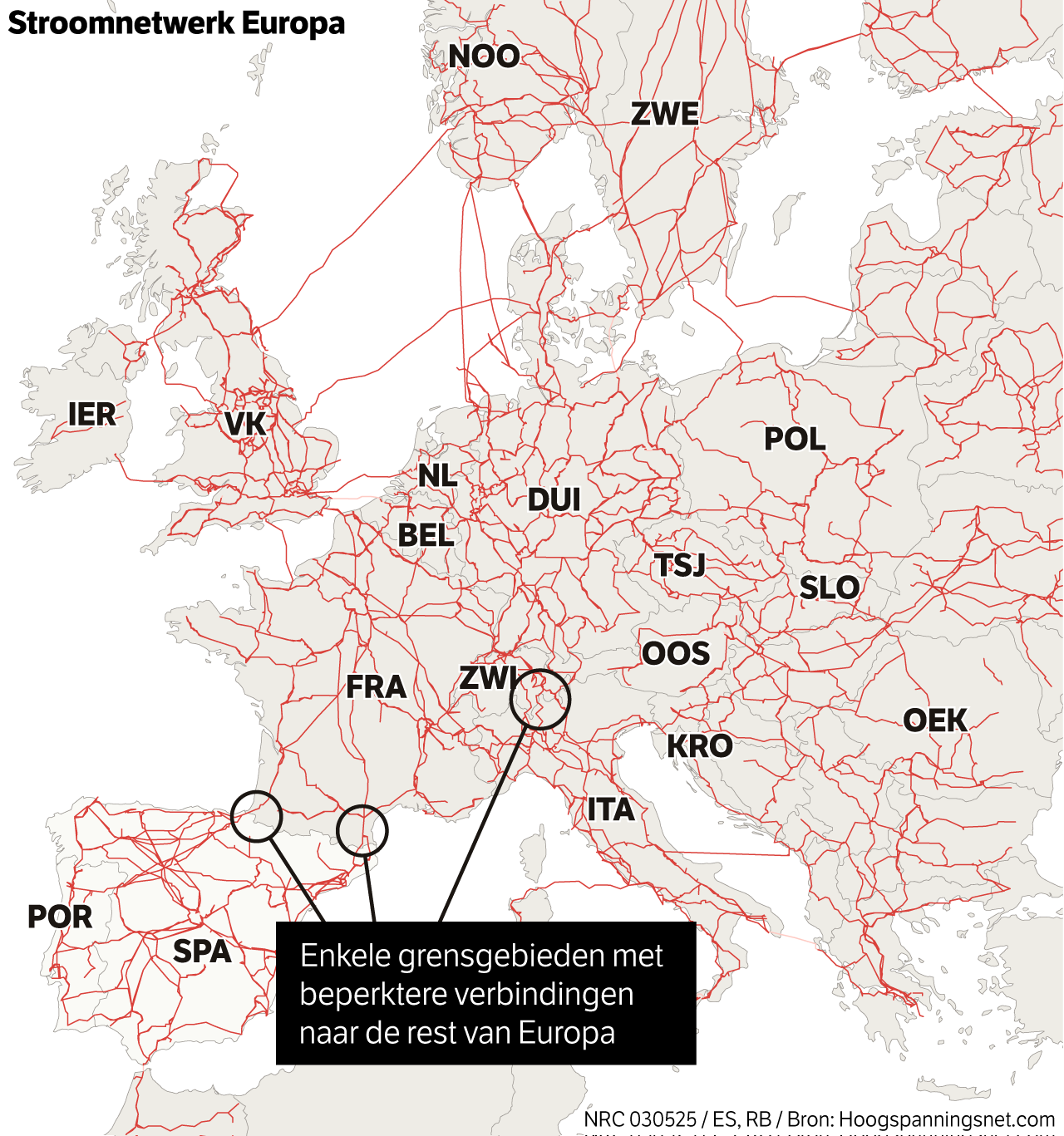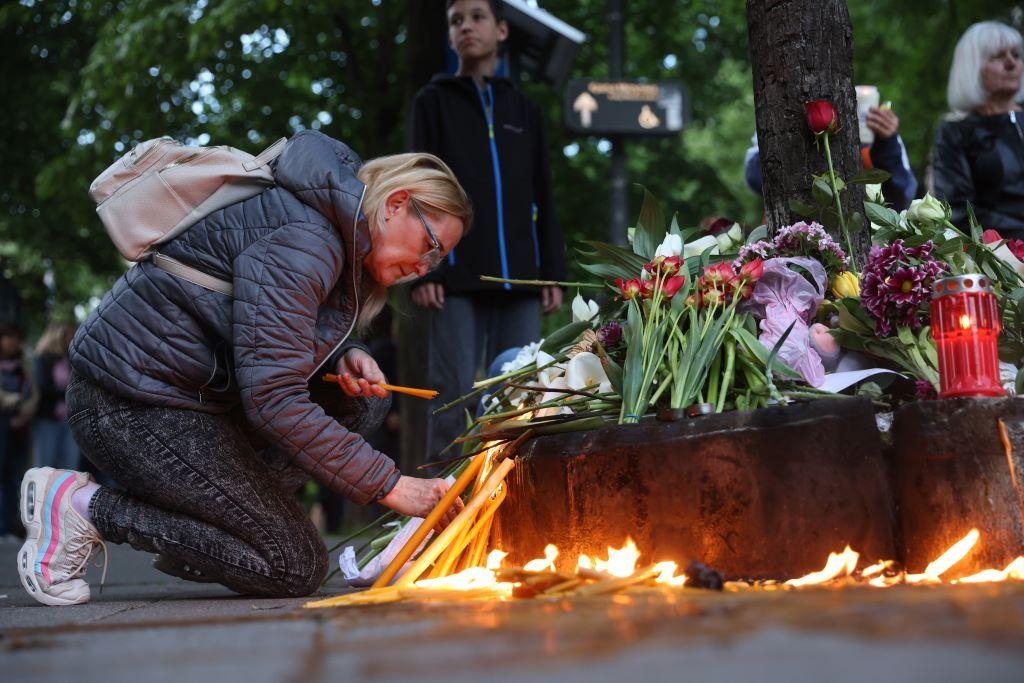During the major power outage on Monday, France received electricity again within thirty seconds, thanks to the EU countries

Millions of kilometers of thick, copper cables underground and lines through the air literally keep European countries connected. They walk from Europe’s northernmost tip to Portugal, to Ukraine and everything in between. Earlier shoots electricity through the cables from one place to another. The power grid is the largest machine that humanity has ever built is sometimes said.
But a machine whose adjustment is closely listened to. Because crucial is that supply and demand are kept precisely balanced every second. What happens if that does not go well can in the worst case lead to large -scale power outages, such as last Monday in Spain, Portugal and part of France.
How this large power outage, one power blackoutcould happen is still unknown. But it has raised the question: how vulnerable is the European power grid, hundreds of millions of people depend on?
It used to be every city or province for itself. Every area installed threads, stations and generators to be able to supply street lighting and machines with power, says Peter Palensky, professor of electricity networks at TU Delft. Like loose islands.
The special thing about a power grid is that the frequency on which the infrastructure is adjusted must remain the same, otherwise parts will be damaged. It is crucial that supply and demand are always in balance, otherwise a malfunction can occur. That is why backups are needed that quickly deliver extra electricity for somewhere supply.
« Soon the realization grew that if you connect those islands, not everyone has to invest in their own super-assured backup power supply, » says Martien Visser, lecturer energy transition at Hanze University of Applied Sciences in Groningen. « In cases of emergency you can borrow electricity from the neighbors, which then temporarily generate a little more. » Palensky: « And if maintenance is done somewhere, the entire city does not have to wait in the dark. Then you just take some power from the neighbors. »
Differences
First the cities and provinces were connected at the national level. Since the Second World War, Land voor Land and in decades, member states have been linked. « That started in the west of Europe, » says Jan Vorrink, senior adviser to TenneT, the manager of the Dutch high -voltage nets, who cooperates with other international network operators in a study into this week’s power outage. « The Baltic states, Moldova and Ukraine have recently been connected. »
In the meantime, the electricity that countries can get from neighboring countries is no longer intended for emergencies. Machiel Mulder, professor of Energy Economics at the University of Groningen: « Since the free market economy has emerged in Europe in the 1990s, market parties have also been using the link to trade energy among themselves. The connection is now being used very intensively. » A bit for emergencies, a lot for trade.
In Portugal they were not happy with the strong European connection last Monday
Slowly a joint, standardized net emerged. The frequency must remain tight all over Europe around 50 Hertz. With abnormalities, other countries are helping to smooth the imbalance. Interconnection makes the power grid more robust and the energy cheaper.
But in Portugal they were not happy with that strong European connection last Monday. Data that the Spanish network operator has so far indicated indicate that the cause of the power outage started in Spain, south of the Pyrenees. A still unknown problem there started a chain reaction in which the malfunction spread like an oil slick. That is why Portugal was also the pinch. Does the connectedness not make the electricity supply more vulnerable?
No, not under the line, four experts say, consulted for this article. If only because countries are obliged to help each other to rebuild the electricity grid after a problem. With the ability of France and Morocco, who helped to get the first few power stations in Spain back to work, almost the entire Iberian island had electricity again less than 24 hours later.
And because countries help each other to prevent a malfunction by smoothing out voltage fluctuations. The evidence that this really works in practice was that Monday’s malfunction did not spread any further in France, says Vorrink van TenneT. In Spain, a lot of capacity disappeared in one fell swoop for unknown reason, and it was not supplemented quickly enough by neighbors. Local therefore automatically switched on the protection on the infrastructure to prevent parts from being damaged. As a result, France suddenly no longer received 2,400 megawatts (enough for seven cities the size of Amsterdam) delivered from Spain. Locally, that caused a temporary malfunction. « But France is well connected to other countries in Europe. That is why all Member States could help France by delivering capacity and continued to connect France. » That all went automatically, within thirty seconds.
Spain and Portugal are connected to the rest of Europe with only a few connections between Spain and France because of their location and Pyrenees that are in between. They could not get the capacity from other countries, such as France. In Spain, the first failed areas had to claim the limited surrounding infrastructure, which then also became overburdened. Then the power was on a large scale in Spain and Portugal. According to a 2023 study in the scientific journal Joule Are such cascadstoicing, in which failure in one area leads to failure in the other, the biggest threat to the modern power grid. Weather conditions are the most common cause of such chain reactions.
The construction of new cables takes billions and years of planning, « but that is no reason for us not to install new links, » says Vorrink. « In the Pyrenees, the Spanish and French network operators have even created a tunnel for a new connection to meet the resistance of nature organizations and residents. » On the contrary, it is activists from the well -connected France who thwart the arrival of new connections with Spain. Network operators want a new connection between the French Bordeaux and the Spanish Bilbao, but especially in the French region of Les Landes, there is resistance because the connection is due to vulnerable nature reserves. Visser: « Now the plan is to lay an even more expensive cable through the Gulf of Biscay instead of the Pyrenees. »
From a geographical point of view, one place in the European network is more vulnerable than the other
According to Visser, the disadvantage of a joint European network is that you sometimes see that countries start to rely on that interconnection and take relatively few measures in the interior to be resistant to a beating. « There is no regulations that require countries to take measures within Europe. For example, Belgium was able to close its nuclear power stations because it assumed that the Netherlands and France would help. »
And yes, a disadvantage is indeed that if there is a problem somewhere, a neighboring country can also be hit, such as Portugal of the Week. But if Portugal had not been connected to the European power grid, they would have had malfunctions much more often, the experts consulted say. Palensky: « Small, local imbalances often happen, but they generally do not lead to malfunctions because we have such a large network. »
From a geographical point of view, one place in the European network is more vulnerable than the other. All eyes are now focused on Portugal and Spain, but you only have to take a map of Europe to see that other areas will also be less connected than Central Europe. Vorrink van TenneT: « For example, all islands, including the Wadden Islands, the United Kingdom, Italy, where in 2003 there was still a large blackout. »
Inertia
Now and in the coming years, the power grid is going on due to gigantic changes, which entail new vulnerabilities. With the addition of renewable energy sources, it becomes more complicated to keep supply and demand balanced every second. The range of solar and wind energy is more difficult to predict in the short term than, for example, a gas plant that you fully control yourself, because weather forecasts will never be perfect. At the same time, adjustable sources such as coal and nuclear power plants are closed.
In addition, solar panels and windmills, for example, have no large, heavy rotating turbines that add ‘slowness’ to the system. If there is a power failure somewhere, then heavy turbines of many tons will continue to turn, they don’t just come to a halt. In the energy world they call that Inertia.
After the failure in Spain, the discussion arose whether solar panels were the cause of suddenly disappearing a large amount of capacity. In the area where the malfunction started, a lot of solar energy is generated. But there were many other sources in the neighborhood, such as nuclear power stations, who do have inertia.
According to Palensky, the extra technical difficulties to keep the net stable should not be used as an argument against the energy transition. « Apart from the need to achieve the climate goals, solar and wind energy also ensure security of supply. » We depend on other countries for fossil fuels. That became clear during the energy crisis after the Russian invasion of Ukraine. Palensky: « Sun and wind have never let us down in millions of years. And nobody can take those sources away from us. »
Moreover, the difficulties that the energy transition entails are technically soluble. Mulder: « We are working on ways to give sustainable sources inertia. For example, by adding flywheels that are driven by solar energy. » Batteries can also simulate inertia. « And because we can, for example, change the corner of the blades of wind turbines in relation to the wind direction, producers with wind turbines can adjust the supply of wind energy somewhat with demand. » But they are extra, rapidly changing challenges that network operators should deal with. That is.
99,99988 percent
And then there are also cyber attacks, which increases the risk due to both current geopolitical tensions and the fact that the net is becoming more and more digitized. Vorrink: « Cyber attacks are indeed a greater risk. We have always taken cyber measures and now we are investing more money in it. » The network operator does not say what those measures are, for safety reasons.
Although the energy transition and cyber attacks make it more difficult for network operators to keep the system in balance and not all areas in Europe are equally well connected, the European just all in all is very reliable. In the Netherlands, for example, the security of supply is 99,99988 percent. That is why worldwide is now so much attention for the malfunction of last Monday: it is very exceptional. The last major malfunction was about twenty years ago.
« We are very dependent on the power grid, » says Han Slootweg, director of operations of network manager Enexis. « We saw that last Monday, when daily life in Spain and Portugal almost stopped. Our dependence on electricity is increasing more and more. And that dependence is the real vulnerability. »

:format(webp)/s3/static.nrc.nl/bvhw/files/2023/11/data107772246-8e777c.jpg)
:format(webp)/s3/static.nrc.nl/wp-content/uploads/2025/01/19180035/data126874263-c22e94.jpg)
:format(jpeg):fill(f8f8f8,true)/s3/static.nrc.nl/podcasts/wp-content/blogs.dir/131/files/2021/03/haagsezakenfeatured.png)

